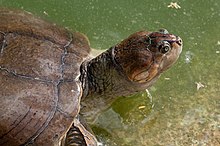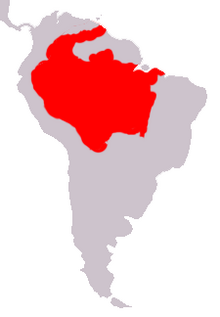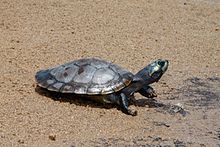Arrau turtle
| Arrau turtle | |
|---|---|

| |

| |
| Scientific classification | |
| Domain: | Eukaryota |
| Kingdom: | Animalia |
| Phylum: | Chordata |
| Class: | Reptilia |
| Order: | Testudines |
| Suborder: | Pleurodira |
| Family: | Podocnemididae |
| Genus: | Podocnemis |
| Species: | P. expansa
|
| Binomial name | |
| Podocnemis expansa (Schweigger, 1812)
| |

| |
| Synonyms | |
| |
The Arrau turtle (Podocnemis expansa), also known as the South American river turtle, giant South American turtle, giant Amazon River turtle, Arrau sideneck turtle, Amazon River turtle or simply the Arrau,[1][3][4][5] is the largest of the side-neck turtles (Pleurodira) and the largest freshwater turtle in Latin America.[5] The species primarily feeds on plant material and typically nests in large groups on beaches.[5] Due to hunting of adults, collecting of their eggs, pollution, habitat loss, and dams, the Arrau turtle is seriously threatened.[5][6][7][8]
Range and habitat
Arrau turtles are found in the
Appearance

Arrau turtles can reach up to 90 kg (200 lb) in weight and the carapace length is up to 1.07 m (3.5 ft).[10] Most individuals are considerably smaller with the average adult female having a carapace length of 64–71 cm (2.1–2.3 ft) and the average adult male 40–50 cm (1.3–1.6 ft).[5] In addition to an overall smaller size, males can be recognized by their longer tail and straighter carapace than the females.[10] Arrau turtles are brown, gray or olive-green,[10] but the exact color varies depending on the algae growing on the carapace.[5]
Behavior
Feeding
Adult Arrau turtles feed almost entirely on plant material such as fruits, seeds, leaves, legumes and algae,
Breeding and life cycle

When nearing the breeding season, Arrau turtles migrate to certain sites where the eggs are laid.[10] In some locations nesting occurs in large groups on beaches,[10] which reduces the risk posed by predators.[5] Some beaches have as many as 500 nesting females.[11] Mating occurs in the water.[11] During and just before the nesting season the species frequently basks, typically in groups. It is suspected that the additional heat accelerates the ovulation in the females.[12] At other times the species is generally not found on land.[12] When on land, it is usually very shy and retreats to the water at the slightest hint of danger.[5] The female lays an average of 75–123 eggs (average varies depending on region),[8] which are placed during the night in a 60–80 cm (2.0–2.6 ft) deep nest that is dug on the beach.[5] The eggs are laid during the low water season and hatch as the water starts to rise. If it rises too fast or too early, the nest is flooded and the young die within the eggs.[8] As long as nests are not dug up by predators, the hatching success rate is usually high, averaging at 83%.[8] The eggs hatch after about 50 days and the sex of the young depends on the nest temperature (females at higher temperatures, males at lower).[5][10] When hatching, the young are around 5 cm (2 in) long and dart directly for the water, but they emerge to the attentions of many predators so that only about five percent ever reach the adult feeding grounds.[13] When hatching, the females emit sounds which attract the young; they stay together for a period in the flooded forests.[14] Vocalizations appear to play an important role in the social life of this turtle and in addition to the "connect to newly hatched young" sound, four primary sounds have been documented during the nesting season: one used during migration, one before basking, one when nesting at night and finally one when in the water after nesting.[14]
They can reach an age of 20 years or more in the wild, and captives have lived for at least 25 years.[5] Based on certain scientific models it has been estimated that the largest individuals perhaps are as old as 80 years.[15]
Conservation status

The Arrau turtle is widespread and was not considered threatened overall by the
The slow growth limits its potential for major commercial turtle farming.[17] Nevertheless, about 880,000 turtles of various species were kept at 92 farms (both ones that are commercial and ones with conservation purpose) in 2004 in Brazil alone,[18] and some of these keep Arrau turtles, also in semi-intensive farm systems.[19]
References
- ^ .
- ^ "Appendices | CITES". cites.org. Retrieved 14 January 2022.
- ^ Podocnemis expansa, The Reptile Database
- ^ ISBN 978-1-5323-5026-9. Retrieved 4 October 2019.
- ^ a b c d e f g h i j k l m n o p q r s t u v Rivas, D. (2015). "Podocnemis expansa (Arrau Sideneck Turtle)" (PDF). The Online Guide to the Animals of Trinidad and Tobago. Retrieved 28 September 2017.
- ^ S2CID 86083211.
- ^ a b Overduin, M. (2 September 2015). "More Than 1,000 Turtles and Nests Protected in Colombia". Turtle Survival Alliance. Archived from the original on 30 August 2018. Retrieved 28 September 2017.
- ^ PMID 14605677.
- ^ PMID 18208597.
- ^ INPA. Retrieved 28 September 2017.
- ^ a b c Rivas, D. "Arrau turtle". Oregon Zoo. Archived from the original on 29 September 2017. Retrieved 28 September 2017.
- ^ a b c Ferrara, C.R.; L. Schneider & R.C. Vogt (2010). "Podocnemis expansa (Giant South American River Turtle). Basking before the nesting season".
{{cite journal}}: Cite journal requires|journal=(help) - ^ The Simon and Schuster Encyclopedia of Animals
- ^ S2CID 85899110.
- ^ a b Hernandez, O. & R. Espín (2006). "Efectos del reforzamiento sobre la población de Tortuga Arrau (Podocnemis expansa) en el Orinoco medio, Venezuela". Interciencia. 31: 424–430.
- ^ a b Peñaloza, C.L.; O. Hernandez & R. Espín (2015). "Head-starting the Giant Sideneck River Turtle (Podocnemis expansa): Turtles and People in the Middle Orinoco, Venezuela" (PDF). Herpetological Conservation and Biology. 10: 472–488.
- ^ PMID 24467796.
- .
- PMID 27693559.
External links
- Forero-Medina, G.; et al. (2019). "On the future of the giant South American river turtle Podocnemis expansa". .

